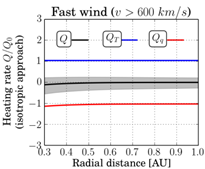Electron energetics in the expanding solar wind

Detailed statistical analysis of electron energetic properties as measured by HELIOS 1&2 spacecraft indicates that for the non-adiabatic cooling of electrons in the expanding solar wind no significant external heating mechanisms are required.
A rather slow cooling of electrons in the expanding solar wind in general do not correspond to theoretical adiabatic predictions. The fundamental question then arises whether the observed evolution of solar wind electrons is due to some external heating mechanisms, like the ubiquitous plasma turbulence, or it is simply caused by the nature of the electron characteristic properties (or it is a combination of both). The solar wind electrons with their mean free path being comparable to local characteristic scales are neither fully collisional nor completely collisionless and are therefore typically found to exhibit many non-thermal features. Consequently, observed electron temperature gradients are controlled not only by the effect of the expansion but also energy transfer provided by the electron heat flux and Coulomb collisions may play an important role.
Using electron velocity distribution functions measured by the HELIOS 1&2 spacecraft Štverák et al. (2015) investigated the energetic evolution of both the slow and fast solar wind streams within 0.3 and 1 AU in the ecliptic plane. The theoretical electron energy balance equation was evaluated by deriving the empirical radial profiles of basic electron macroscopic properties (i.e., density, temperature, and heat flux). The derived empirical radial profiles do not indicate any external heat source to be required to explain the observed temperature gradients for both the slow and fast solar wind streams. Actually, in the slow wind the results even indicate a significant external cooling to take place. The observed nature of the electron thermal evolution proves the internal energy transport mechanisms to be more effective in the slow than in the fast wind streams. From the macroscopic point of view the electron cooling caused by the expansion is significantly slowed down by the internal electron heat flux. The Coulomb collisions then play an important role in the energy transfer from the parallel to the perpendicular direction with respect to the ambient magnetic field lines.
.png) Figure:
Figure: Normalized electron energization rates Q as a function of the heliocentric radial distance derived for the slow (right) and fast (left) solar wind streams. The total rate Q is derived for the isotropic approach (top) as a product of the electron heating required by the solar wind expansion and competing electron cooling resulting from the electron heat flux gradient. In the anisotropic approach (bottom) the total rate Q is expressed as an energy transfer from the parallel to the perpendicular direction. The normalization is done to the internal electron energy per expansion time.
References:
Štverák, Š., P. M. Trávníček, and P. Hellinger (2015), Electron energetics in the expanding solar wind via Helios observations, J. Geophys. Res. Space Physics, 120, 8177–8193, doi:10.1002/2015JA021368.